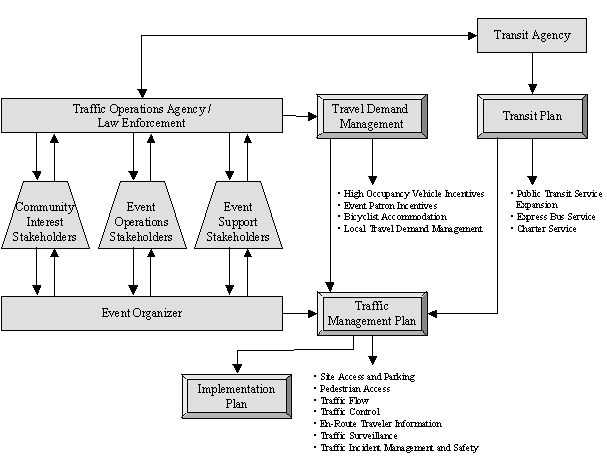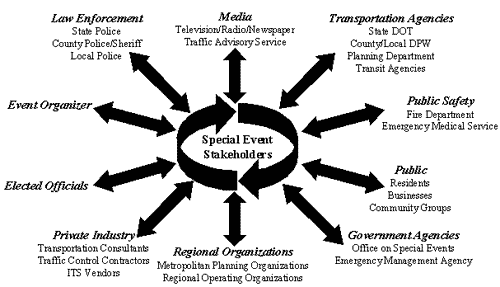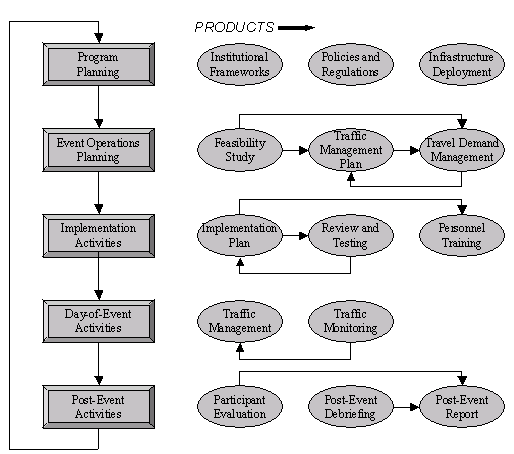
Managing Travel for Planned Special Events
Chapter Three. Overview
Page 2 of 8
Background 
In the past, the media has reported horrendous traffic congestion that has occurred at several major planned special events. In one instance, golfers participating in a major professional golf tournament were caught in major traffic jams along with event patrons and other motorists. Facing a 2-stroke penalty or disqualification if they arrived at the first tee past their assigned tee time, several players pulled their cars to the side of the road, carried their golf bags, and walked to the course. These situations emphasize the need for this handbook, which presents policies, guidelines, procedures, strategies, and resource applications that assure the successful management of travel for planned special events.
What is Managing Travel for Planned Special Events?
A planned special event creates an increase in travel demand and may require road closures to stage the event. Planned special events generate trips, thus impacting overall transportation system operations. This includes freeway operations, arterial and other street operations, transit operations, and pedestrian flow. Unlike roadway construction activities or traffic incidents that constrain travel within a single corridor, planned special events affect travel in all corridors serving the event venue.
Managing travel for planned special events involves developing a transportation management plan that contains operations and service strategies specific to managing traffic, transit, and travel demand. As shown in Figure 3-2, a transportation management plan consists of three components:
- Traffic management plan
- Transit plan
- Travel demand management initiatives

Figure 3-2. Transportation Management Plan Components and Event Planning Team Involvement D
Traffic operations agencies, transit agencies, law enforcement agencies, and event organizers represent key stakeholders in the transportation management plan development process because of the responsibility they bear in developing, approving, and implementing the plan. To ensure that the plan addresses the requirements of all those impacted, the event planning team should be comprised of a wide range of stakeholders:
- Event operations stakeholders focus on mitigating the safety, mobility, and reliability impacts on transportation operations.
- Community interest stakeholders seek to minimize impacts on community quality of life and maximize potential social and economic benefits.
- Event support stakeholders serve to support and execute the transportation management plan by following proposed initiatives or providing necessary resources for plan deployment.
Stakeholder Roles and Coordination
The advance planning and management of travel for planned special events requires the consistent involvement and coordination of stakeholders throughout all phases of the event. Table 3-1 indicates the responsibilities of the three stakeholder groups.
- An oversight team involves mid-to-upper level representatives of transportation agencies and law enforcement. Additional stakeholders include elected officials, regional organizations, and other government agencies.
- The event planning team consists of mid-level representatives of transportation agencies and law enforcement as well as the event organizer, media, public safety agencies, private industry, and the public.
- A traffic management team includes operations managers and field personnel representing transportation agencies, law enforcement, the event organizer, media, and private industry.
| Stakeholder Group | Function |
|---|---|
| Oversight Team |
|
| Event Planning Team |
|
| Traffic Management Team |
|
Major annual event or venue task forces exist in some jurisdictions that serve the role of both an oversight team and event planning team. The task force may meet year-round to mitigate lessons learned from past events, then expand to include additional event operations stakeholders as the next event nears.
Figure 3-3 presents common stakeholders, representing various disciplines and jurisdictions, that play an active role in managing travel for planned special events on a local and/or regional level.

Figure 3-3. Planned Special Event Stakeholders
The following subsections describe the potential roles and responsibilities of each identified stakeholder in addition to his or her coordination with other planned special events stakeholders.
Transportation Agencies
Transportation agencies own and operate the transportation system serving a planned special event. These agencies staff all three of the above mentioned stakeholder groups, although actual personnel may vary from group to group. Because of their involvement in every phase of managing travel for planned special events, transportation agencies have the unique opportunity to form partnerships with other stakeholders at different working levels. Such partnerships may lead to: (1) creation of interagency agreements at the program planning or oversight level, (2) agreement to share closed-circuit television (CCTV) video at the event operations planning or mid-level, and (3) improvement of communications and coordination at the field level.
A state department of transportation (DOT) typically leads advance planning and day-of-event traffic management for freeway and/or arterial corridors serving an event venue. This includes operating a traffic management system to monitor, advise, and control traffic flow on these high-capacity routes. A state DOT may also facilitate the acquisition and deployment of portable, advanced technology equipment providing increased traffic management and monitoring capabilities.
A local or county department of public works (DPW) may include traffic engineers participating in program planning, event operations planning, and day-of-event traffic management. At the program planning level, the agency may initiate infrastructure improvement projects or establish traffic control guidelines for event permits. Event operations planning activities may include developing or reviewing proposed traffic management plans and developing traffic signal system timing plans to accommodate anticipated fluctuations in traffic demand. The agency has authority to enact temporary traffic and parking restrictions on streets adjacent to an event venue. Traffic engineers often serve a supervisory role on a traffic management team. In general, agency officials must monitor and maintain traffic flow traversing their jurisdiction. A local/county DPW assumes an expanded role in traffic operations planning and management for local level planned special events. The agency may also utilize roadway maintenance personnel to deploy required temporary traffic control devices, repair potholes along a parade route, and perform post-event street sweeping.
A planning department may administer a permit program for special events while a local jurisdiction planning commission may rule on the transportation component of an event permit application.
The previous section described the role of transit agencies in managing travel for planned special events, which may include service expansions and achieving cooperative agreements with private bus companies to obtain additional equipment and drivers.
Law Enforcement
Law enforcement agencies facilitate the safe and efficient flow of traffic during a planned special event through traffic control and enforcement. Agencies contribute to all phases of planned special events, particularly event-specific advance planning and traffic management. Local and county law enforcement having a traffic operations bureau may take responsibility for developing and executing a local street traffic management plan. Other potential duties of law enforcement include approving local street closures, approving an event traffic flow plan, approving temporary traffic control deployment, escorting dignitaries to/from the event venue, and enforcing the requirements of a traffic operations agency.
Event Organizers
Event organizers initiate the event operations planning phase by notifying stakeholders, either through a written request to public agencies or the submission of an event permit application, and assembling an event planning team. The event organizer continually works to maintain interagency coordination in order to meet milestones in the advance planning process and ultimately gain stakeholder approval of the proposed transportation management plan. The event organizer may hire a private traffic engineering consultant to perform an event feasibility study and prepare a traffic management plan. The event organizer may also fund the deployment of equipment and personnel resources, including reimbursement of public agency personnel costs, required to mitigate traffic safety, mobility, and reliability impacts during the day-of-event. An event venue operator essentially represents an event organizer. These venue operators may work together with transportation agencies, law enforcement, and elected officials during the program planning phase to develop strategies, including permanent installation of equipment for improved traffic monitoring and control, to better accommodate traffic and transit access to the venue.
Elected Officials
Elected officials serve the overall community interest and often play a significant role on an oversight team. Local politicians can establish laws and regulations toward effecting improvements in planning and managing future planned special events. They may create a special task force to assist event organizers and local agencies to coordinate event planning activities. Local district politicians may advise an event planning team on alternatives to minimize quality of life impacts on represented residents and businesses.
Public Safety
Public safety agencies, including a fire department and emergency medical service, represent event operations stakeholders that advise the event planning team on the provision of emergency access routes to and from the event venue. Public safety agencies, in addition to law enforcement and an emergency management agency, also work as part of the event planning team to ensure adequate pedestrian access routes and evacuation destination areas exist to meet emergency management plan requirements.
Media
The media functions to disseminate event pre-trip travel information, in addition to real-time traffic and transit information during the day-of-event. A media representative may participate in a meeting of the event planning team to obtain advance information on proposed temporary traffic control, transit, and travel demand management initiatives. However, the media generally works independently of the traffic management team on the day-of-event.
Private Industry
Private industry satisfies a wide range of public agency needs from the event operations planning phase through the day-of-event activities phase. Traffic engineering consultants may assume the role of a public agency traffic engineer and, in turn, develop a transportation management plan and manage either an event planning team, traffic management team, or both. Private traffic control contractors, such as barricade companies, fulfill the duties of a transportation agency maintenance department. Intelligent Transportation Systems equipment vendors contract with transportation agencies to:
- Supply and install on streets serving a fixed event venue, permanent equipment such as CCTV cameras, lane control signals, dynamic trailblazers, and parking management systems
- Deploy portable traffic management systems, including portable CCTV, portable changeable message signs (CMSs), portable highway advisory radio (HAR), portable vehicle detectors, and portable traffic signals.
In some instances, transportation agencies may arrange for an equipment demonstration, at no cost to the agency, to evaluate the performance of a particular technology application during a planned special event.
Regional Organizations
Regional organizations interact with both the oversight team and an event planning team regarding major planned special events affecting a regional area. A Metropolitan Planning Organization (MPO) oversees the planning and programming of transportation management strategies. For example, the agency may communicate and seek feedback on temporary travel demand management strategies with commuter groups and trucking companies. A MPO may loan staff to other public agencies in need of personnel to conduct planning and operations activities. The agency may also establish and/or coordinate temporary task forces charged with a particular function, such as event communications. A Regional Operating Organization (ROO) consists of traffic operations agencies, transit agencies, law enforcement, elected officials, and other operations agencies focused on the operation and performance of a regional transportation system. A ROO works to ensure interagency coordination of resources and information across jurisdictional boundaries. It builds partnerships and trust among agencies to improve their productivity and performance, thus creating a more responsive approach to mitigating temporary capacity deficiencies. ROO member agencies may, for example, share traffic signal timing plans, coordinate planned strategies and resources for managing travel, conduct public outreach, and participate in interagency training.
Government Agencies
Government agencies, such as a government office on special events or emergency management agencies, are non-transportation agencies that generally serve in an oversight capacity. A government office on special events may work in tandem with the event organizer to initiate the event operations planning phase and coordinate event planning team stakeholders. Other emergency management and security agencies may meet with the event planning team to obtain an advance debrief on transportation management plan specifics.
Public
The public represents individual residents, businesses, and associated community groups. Residents and businesses potentially impacted by intense traffic and parking demand generated by a planned special event may interact with event planning team stakeholders during a public meeting. This permits concerned citizens the opportunity to review and comment on proposed traffic and parking restrictions needed to accommodate event traffic.
Phases of Managing Travel for Planned Special Events
The practice of managing travel for planned special events incorporates advance planning, management, and evaluation activities encompassing five distinct, chronological phases. Figure 3-4 summarizes the five phases and common products generated by coordinated stakeholder groups under each phase. Collectively, these phases facilitate the successful management of transportation system operations during a planned special event.

Figure 3-4. Planned Special Event Management Phases and Associated Products D
Integration of the identified phases, from the post-event activities phase to the program planning phase, creates a seamless process allowing for continuous improvement of transportation system performance from one event to the next, especially in regard to recurring events or events occurring at permanent venues. This iterative process, where stakeholders apply successes and lessons learned from a particular special event to future events, supports activities pertaining to managing travel for all planned special events in a region. Recognition and integration of special event management phases achieves coordination across stakeholder groups, namely the oversight team, event planning team, and traffic management team.
Planned Special Events Traffic Management | Privacy Policy